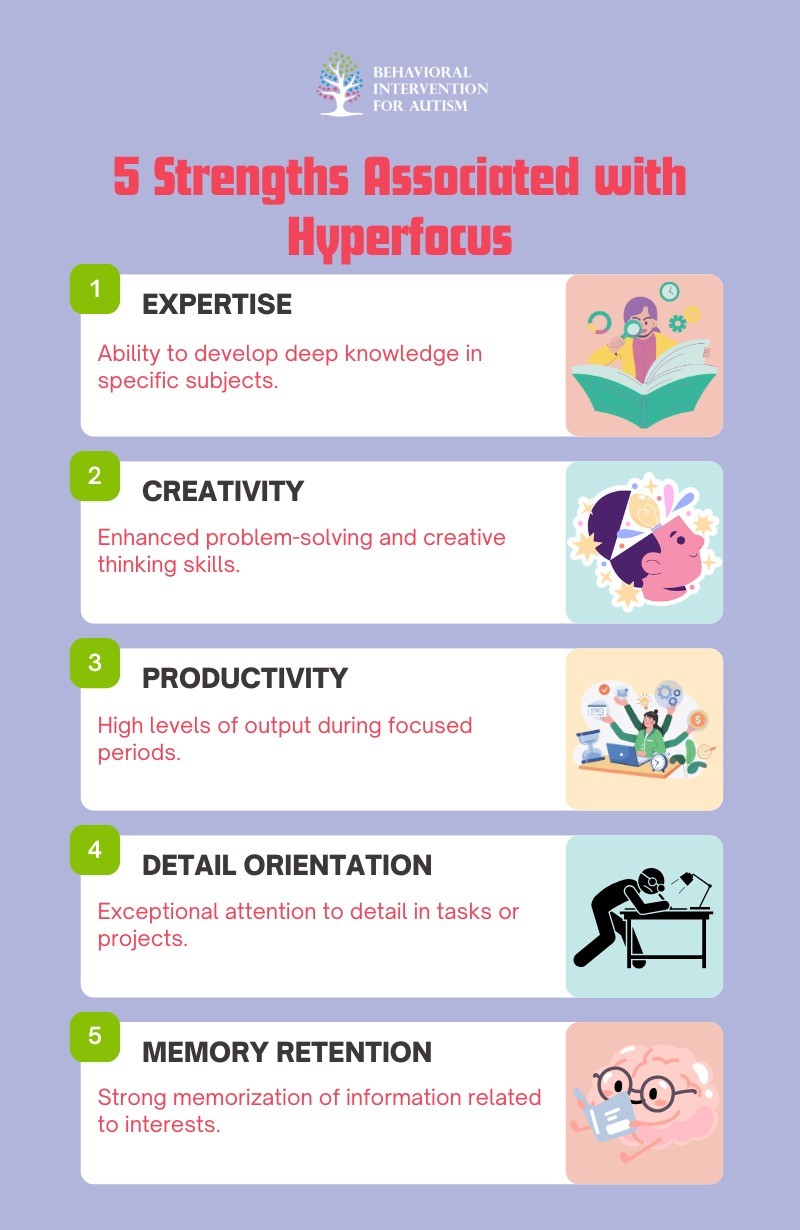
Table of Contents
Hyperfocus refers to an intense concentration on specific tasks or interests that can dominate an individual’s attention for extended periods. This phenomenon is commonly observed in individuals on the autism spectrum. For many, hyperfocus allows them to dive deeply into subjects they are passionate about, leading to remarkable knowledge and skill development in those areas.
4 characteristics of hyperfocus may include:
Characteristics | Description |
Intense Concentration | Extreme focus on a particular topic or activity. |
Distortion of Time Perception | Loss of awareness of time passing during activities. |
High Level of Detail | Ability to remember intricate details related to the interest. |
Resistance to Distractions | Difficulty shifting attention away from the task. |
The Power of Hyperfocus
Hyperfocus is a unique characteristic often observed in individuals with autism. It encompasses both strengths and challenges. The strengths and challenges of hyperfocus are explored.
5 Strengths Associated with Hyperfocus
Individuals with autism often experience intense concentration on preferred activities or interests. This deep focus can lead to remarkable achievements and skills. Below are some common strengths linked to hyperfocus:

Many individuals leverage these strengths in areas such as hobbies, academics, or career pursuits. Encouraging and nurturing these strengths can promote increased self-esteem and motivation.
5 Challenges of Hyperfocus in Autism
While hyperfocus can offer many advantages, it can also bring certain difficulties. Below are notable challenges that may arise:
Challenges | Description |
Lack of Awareness | Difficulty in recognizing the passage of time or external stimuli. |
Neglecting Responsibilities | Tendency to overlook daily tasks or obligations while hyperfocused. |
Social Isolation | Potential for withdrawal from social interactions and relationships. |
Frustration | Possible frustration when transitioning away from hyperfocused tasks. |
Limited Flexibility | Challenges in switching attention to other tasks or subjects. |
These challenges may necessitate support and strategies to help individuals manage their hyperfocus effectively. Balancing the advantages and difficulties is essential to enhancing their overall well-being.
Recognizing and Supporting Hyperfocus
Understanding hyperfocus is essential for parents and caregivers of individuals with autism. Recognizing the triggers and creating an environment conducive to hyperfocus can support productive engagement and learning.
Identifying Hyperfocus Triggers
Hyperfocus can be associated with specific stimuli or activities that capture the individual’s attention. Identifying these triggers is vital to harness the benefits of hyperfocus. Common triggers may include:
Type of Trigger | Examples |
Activities | Drawing, building, coding |
Topics of Interest | Dinosaurs, space, technology |
Sensory Stimuli | Specific sounds, smells, textures |
Social Interactions | Engaging with like-minded peers |
By documenting these triggers, parents can better understand when hyperfocus is likely to occur.
Creating an Optimal Environment for Hyperfocus
An optimal environment can enhance the experience of hyperfocus. Key factors to consider include:
Environment Factor | Recommendations |
Lighting | Use natural light or soft, adjustable lighting |
Distractions | Minimize noise and visual clutter |
Comfort | Provide comfortable seating and ergonomic spaces |
Resources | Ensure access to necessary tools or materials |
Schedule | Establish a routine that allows for uninterrupted time |
Parents can modify these aspects to create a space where the individual can engage deeply with their interests, thereby maximizing the potential benefits of hyperfocus while managing any associated challenges.
Nurturing Hyperfocus in Everyday Life
Fostering hyperfocus in everyday life can greatly benefit individuals with autism. By encouraging a healthy balance and cultivating other interests and skills, parents and caregivers can help harness this unique ability while ensuring overall well-being.
Encouraging a Healthy Balance
Achieving a balance between hyperfocus and other life activities is vital. Parents can create a structure that allows for intense focus on interests without neglecting responsibilities and social interactions. Establishing a routine can aid in this balance.
Setting specific times for focused activities and breaks can guide individuals in managing their time effectively. Utilizing timers can also support transitions between focused activities and other responsibilities.
Cultivating Other Interests and Skills
While hyperfocus can be advantageous, developing a range of interests and skills is equally important. Parents should encourage exploration of various activities that may capture attention, thereby reducing reliance on a single area of focus.
Introducing diverse experiences through structured activities can help individuals develop new skills and interests. Parents should remain patient, recognizing that it may take time for individuals to engage in activities outside their primary focus.
Take the Next Step Toward Personalized Support
If you’re ready to help your child thrive, reach out to us today. At Behavioral Intervention for Autism, we provide high-quality ABA therapy services tailored to each individual’s needs. Our compassionate team focuses on fostering meaningful progress, empowering individuals to build essential life skills while embracing their unique strengths. With our specialized ABA programs in Florida, we’re dedicated to delivering effective, evidence-based strategies that make a real difference. Don’t wait—contact us now and discover how we can support your family’s journey. Together, we can unlock new opportunities and create lasting, positive change.
Sources:
- 9 Common Obsessions of Children With Autism You Should Know - February 25, 2025
- What is Neurodiversity? A Guide to Embracing Differences - February 25, 2025
- Understanding Hyperfocus in Autism: What It Means and Why It Happens - February 25, 2025

